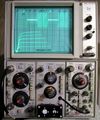5CT1N: Difference between revisions
Jump to navigation
Jump to search
m (→top: clean up, replaced: title=Tektronix → manufacturer=Tektronix |type=, {{Plugin Sidebar 2 → {{Plugin Sidebar) |
No edit summary |
||
| Line 1: | Line 1: | ||
{{Plugin Sidebar | {{Plugin Sidebar | ||
|manufacturer=Tektronix | |manufacturer=Tektronix | ||
|type= 5CT1N | | |series=5000-series scopes | ||
summary=Curve tracer plug-in | | |type=5CT1N | ||
image=5ct1n-crop.jpg | | |summary=Curve tracer plug-in | ||
caption=5CT1N curve tracer | | |image=5ct1n-crop.jpg | ||
introduced=1972 | | |caption=5CT1N curve tracer | ||
discontinued=1988 | | |introduced=1972 | ||
designers=| | |discontinued=1988 | ||
manuals= | |designers= | ||
|manuals= | |||
[[Media:070-1246-00.pdf|Tektronix 5CT1N Manual (PDF)]] | [[Media:070-1246-00.pdf|Tektronix 5CT1N Manual (PDF)]] | ||
}} | }} | ||
Revision as of 08:18, 16 August 2021
The Tektronix 5CT1N is a curve tracer plug-in for the 5000 series oscilloscopes, similar to the 7CT1N for 7000-series scopes.
Key Specifications
| DUT drive voltage (C-E) |
|
|---|---|
| DUT current display |
|
| Base/Gate drive |
|
| DUT connection | Three 4 mm jacks / binding posts |
Links
- Tekscope Vol. 4 No. 6, Nov 1972
- Dennis Tillman: An Inexpensive Vacuum Tube Curve Tracer Adapter for All Tektronix Semiconductor Curve Tracers
Pictures
-
5Ct1N in 5440 mainframe vertical bay, X output connected to time base X input
-
Displaying transistor curves
-
-
Common Problems
C30 and C32 (100 μF, 25 V) are under-rated and therefore have a tendency to leak or short, causing associated resistors R30 and R32 (240 Ω, 0.25W, 5%) to overheat and fail. C30 and C32 should be replaced with modern equivalents rated above 35 V.




